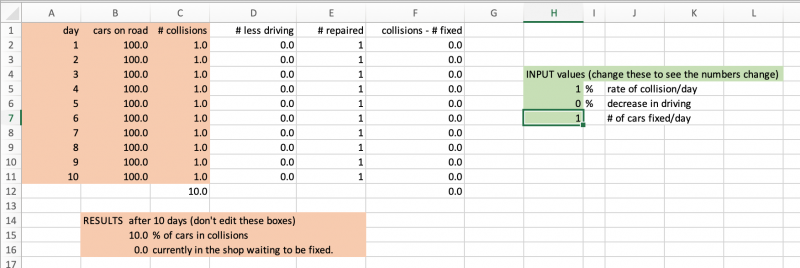COVID-19 Example
Many people, rightly or wrongly, ask my opinion about science related things. I ass-u-me they view me as "smart" and hence value my opinion. My first response to them should be, "you should not care about my opinion (or what i think)" but that they should ask if i have any data to help them process their question.
I was recently asked whether this COVID-19 situation and resulting restrictions were a valid thing to do. I responded with data. Here is what i said:
So let's think about this spread of the coronavirus in terms of an interstate highway. For example, consider 100 cars driving on the highway. If, for some reason the number of car collisions increases from 1/day to 10/day due to some universal manufacturing defect, one could make the following prediction:
- Day 1 - 100 cars, 10 collisions, only 90 cars still driving
- Day 2 - 90 cars, 9 collisions, 81 cars still driving
- Day 3 - 81 cars, 8.1 (~8) collisions, 73 cars still driving
- Day 4 - 73 cars, 7.3 (~7) collisions, 66 cars still driving
- Day 5 - 66 cars, 6.4 (~6) collisions, 60 cars still driving
- Day 6 - 60 cars, 6 collisions, 54 cars still driving
- Day 7 - 54 cars, 5.4 (~5) collisions, 49 cars still driving
- Day 8 - 49 cars, 4.9 (~5) collisions, 44 cars still driving
- Day 9 - 44 cars, 4.4 (~4) collisions, 40 cars still driving
- Day 10 - 40 cars, 4 collisions, 36 cars still driving
- - Total collisions after 10 days = 64 or 64% of the car population.
If we re-do the calculations above and by lowering the 10% collision rate to 6.7%, then after 10 days, 50% of our car population damaged and 50% still driving. But what if we add another factor, % of people who choose not to drive due to this increase in collision rates.
- - If 10% of the population stops driving, then after 10 days, 34% of our cars will be damaged (as opposed ot 64%),
- - If 20% of the population stops driving, then after 10 days, 24% of our cars will be damaged,
- - If 30% of the population stops driving, then after 10 days, 18% of our cars will be damaged,
- - If 50% of the population stops driving, then after 10 days, 12% of our cars will be damaged,
Now we cannot just stop driving altogether, but if the manufacturers were able to fix the default in 10 days, then we could all start driving again and all would be good.
Here is the second half of the above conversation: Now, considering that the auto repairs shops in town are "tooled" to fix the number of cars that get into accidents (why would they build more capacity then needed?)...or 1% per day, the usual rate of collisions. Therefore, considering the 100 cars under discussion, 10% collision rate, and 1% repair rate:
- Day 1 - 100 cars, 10 collisions, only 90 cars still driving, but 1 is fixed, 9 are waiting to be repaired.
- Day 2 - 91 cars, 9.1 (~9) collisions, 82 cars still driving, but 1 is fixed, 8 more are added to the waiting to be repaired list.
- Day 3 - 83 cars, 8.3 (~8) collisions, 75 cars still driving, but 1 is fixed, 7 more are added to the waiting to be repaired list.
- Day 4 - 76 cars, 7.6 (~8) collisions, 68 cars still driving, but 1 is fixed, 7 more are added to the waiting to be repaired list.
- Day 5 - 69 cars, 6.9 (~7) collisions, 62 cars still driving, but 1 is fixed, 6 more are added to the waiting to be repaired list.
- Day 6 - 63 cars, 6.3 (~6) collisions, 57 cars still driving, but 1 is fixed, 5 more are added to the waiting to be repaired list.
- Day 7 - 58 cars, 5.8 (~6) collisions, 52 cars still driving, but 1 is fixed, 5 more are added to the waiting to be repaired list.
- Day 8 - 53 cars, 5.3 (~5) collisions, 48 cars still driving, but 1 is fixed, 4 more are added to the waiting to be repaired list.
- Day 9 - 49 cars, 4.9 (~5) collisions, 44 cars still driving, but 1 is fixed, 4 more are added to the waiting to be repaired list.
- Day 10 - 45 cars, 4.5 (~5) collisions, 40 cars still driving, but 1 is fixed, 4 more are added to the waiting to be repaired list.
- - Total collisions after 10 days = 67 or 67% of the car population.
So, the effect of the car repair on the situation is to increase the number of cars on the road and hence increase the number of overall collisions. BUT...after 10 days there are 59 cars STILL IN THE SHOP! If we could increase repair capacity to repair 3 cars per day (as opposed to 1/day), after 10 days we would still have 46 cars waiting to be repaired. As you might expect, we would need to increase the rate of repairs to equal the rate of collisions, ie 10/day in order to have all cars back on the road.
With auto repair, they all have parking areas where cars wait to be fixed...this is not the case for people.
It is my opinion that you should stop driving your car now.
As you might expect, i did all of these calculations in Excel. My final spreadsheet looked like this:
Please construct this above spreadsheet; below is a set of number to check your calculations.

